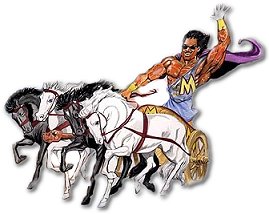
WELCOME TO MYTH MAN'S
AWARD-WINNING HOMEWORK HELP
ASCLEPIUS (ASCLEPIOS)
GOD OF HEALING & MEDICINE

| Some say that to prevent further conflict with his son Apollo, Zeus later resurrected Asclepius, transformed him into a god and permitted him residence on Olympus. |
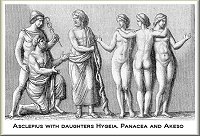 CLICK TO ENLARGE |
| Eventually Asclepius married a woman named Epione, and together they had six daughters and three sons, who are essentially the personification of his healing powers. |
T.gif) |
| The cult of Asclepius was celebrated in many places, including in Trikala, Arcadia, and even at Pergamum in Asia. However, his most famous temple was at Epidaurus, located in the region of Peloponnese. |
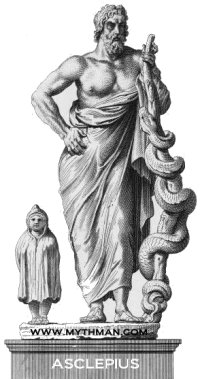 CLICK TO ENLARGE |
| Other representations show him holding in one hand a phial, and in the other a staff. Sometimes a boy is depicted standing by his side - He is the genius of recovery, and is called Telesphorus, Euamerion or Acesius. |
|
|
Asclepius was the ancient Greek god of healing and medicine. His father was the great god Apollo, and his mother was a mortal princess called Coronis (sometimes spelled Koronis). One version of the birth of Asclepius holds that Coronis died in childbirth, and her body was laid out on a funeral pyre to be consumed by fire.
However his father Apollo managed to rescue the child from the flames, cutting him from her womb before he perished. Thus his given name of Asclepius, which means "to cut open."
Another version of his birth claims that his mother Coronis was unfaithful to Apollo. While pregnant with Apollo's baby, she had seen and fallen in love with a man named Ischys. Apollo had ordered a raven to follow her, and upon hearing the news about her infidelity, asked his sister Artemis to find the unfaithful woman.
The enraged Apollo then proceeded to curse and transform the raven into pitch black, whereas previously it had been pure white. This was its punishment for delivering the bad news about Coronis and Ischys.
Others say that it was Apollo's own power of prophecy that revealed Coronis' betrayal. In either case, Artemis located Coronis in her house at Lacareia in Thessaly and told her brother her whereabouts.
It was said to be Apollo himself who killed Coronis and her lover Ischys, then laid her out on the funeral pyre to be burned, but that either Apollo or, in some versions, Hermes, rescued the unborn baby before it was too late.
Apollo delivered Asclepius to the respected Centaur called Chiron, who was half-man and half-horse. The centaur tutored young Asclepius in many things, but mainly in the arts of medicine and hunting.
Eventually Asclepius married a woman named Epione, and together they had six daughters and three sons, who are essentially the personification of his healing powers:
Daughters - Aceso, Aglaea, Hygeia, Iaso, Meditrina and Panacea.
Sons - Machaon, Podaleirios and Telesphoros.
Asclepius also had a son named Aratus with a different woman, whose name was Aristodama.
Asclepius was said to be one of the participants in the famous hunt for the Calydonian Boar. He was usually depicted as a bearded and kindly-looking man holding a snake-entwined staff.
How did Asclepius develop his healing powers? There are two versions:
1) Asclepius had received from the goddess Athena the blood of the slain Gorgon. The blood that had flowed from the veins on the right side of her body possessed the power of restoring the dead to life, while the blood from the left veins were used to destroy people.
2) Another tradition holds that Asclepius had been standing at the house of Glaucus, whom he had been asked to cure, when a serpent came and twined itself around his staff. He proceeded to kill this snake.
Another serpent then appeared, carrying in its mouth a medicinal herb. Asclepius used this herb to bring the original snake back to life, then used the same herb to perform the same life-restoring healing on humans.
Asclepius was said to have resurrected a man named Hippolytus, or even the aforementioned Glaucus, from the dead for a fee of gold. This angered the king of the Olympians, Zeus, who had expressly forbidden this act. He feared that men might conspire to bypass death altogether. Zeus struck down Asclepius with a thunderbolt, killing him instantly.
Another version of his death holds that Hades became angry at Asclepius because he kept bringing back people from the dead. The lord of the Underworld believed that no more dead spirits would venture to his realm, and thus asked his brother Zeus to dispose of him.
The murder of his son incensed Apollo, who retaliated by slaying the mighty Cyclopes, the giant one-eyed craftsmen that had created Zeus' thunderbolts.
Needless to say Zeus was so furious at Apollo that he banished him from Mount Olympus and ordered him to obediently serve King Admetus of Thessaly for a period of one year.
Following the year-long sentence Apollo was permitted by Zeus to return to the home of the gods, and simultaneously Zeus brought the Cyclopes back to life, because he was grateful to them for presenting him with the almighty thunderbolts.
All was well on Mount Olympus. Zeus was also alleged to have placed the body of Asclepius among the stars following his death, as the constellation called Ophiuchus, which translates to "The Serpent Holder."
Some say that to prevent further conflict with his son Apollo, Zeus later resurrected Asclepius, transformed him into a god and permitted him residence on Olympus.
The cult of Asclepius was celebrated in many places, including in Trikala, Arcadia, and even at Pergamum in Asia. However, his most famous temple was at Epidaurus, located in the region of Peloponnese.
His temple at Epidaurus was surrounded by an extensive grove, within which no one was allowed to die, and no woman permitted to give birth to a child.
An artisan named Thrasymedes had constructed a magnificent statue made of gold and ivory, located inside the sanctuary at Epidaurus. Asclepius was represented as a handsome and manly figure, much like Zeus. He was seated on his throne, holding a staff in one hand, and with the other resting on the head of a serpent/dragon. By his side lay a dog.
Other representations show him holding in one hand a phial, and in the other a staff. Sometimes a boy is depicted standing by his side - He is the genius of recovery, and is called Telesphorus, Euamerion or Acesius.
His temples were strategically built in places that exuded healthiness, such as hills outside of town, or near wells which were said to have healing powers. Very much like our modern day hospitals, these temples were not only places of worship, but were also filled by great numbers of sick people seeking cures.
There was a famous healing temple, or asclepieion, on the island of Kos, where the legendary father of medicine, Hippocrates, was rumored to have begun his medicinal career. It goes without saying that many towns were eager to claim Asclepius as their own.
Depictions of Asclepius almost always show him holding a staff with snakes. This is often confused with the Caduceus of the god Hermes, which is differentiated by two wings at the top, and two snakes, compared with one snake for the staff of Asclepius.
These non-venomous snakes, called the Aesculapian Snakes, were used in healing rituals to honor Asclepius. The snakes were let loose to slither freely around the floor where the sick people or those who were injured lay or slept. They were considered good luck and were not harmed.
Eventually the cult of Asclepius grew very popular, with pilgrims and the sick flocking to his temples to be healed of their ills. They would make offerings according to their means and would spend one or two nights in the abaton (or abyton), which was the holiest part of the the temple.
Any dreams or visions experienced at the abaton would the next morning be relayed to the temple priest, who would interpret the dream and prescribe an appropriate therapy, remedy or medicine. Sacred dogs were sometimes used at some of Asclepius' temples, to lick the wounds of the sick.
Sacrifices of a rooster or a goat would be offered by those cured at Asclepius' temples, and a tablet would be hung up recording the name of the sick, the disease, and the fashion in which the person had been cured. The temples at his main places of worship were filled with such tablets, with some still surviving to this day.

| The original Hippocratic Oath began with the invocation, "I swear by Apollo the Physician and by Asclepius and by Hygeia and Panacea and by all the gods." |
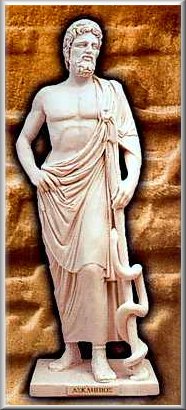 |
| Asclepius was said to be one of the participants in the famous hunt for the Calydonian Boar. He was usually depicted as a bearded and kindly-looking man holding a snake-entwined staff. |
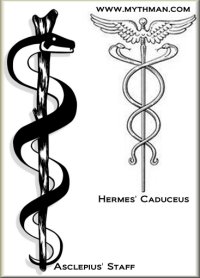 CLICK TO ENLARGE |
| Depictions of Asclepius almost always show him holding a staff with snakes. This is often confused with the Caduceus of the god Hermes, which is differentiated by two wings at the top, and two snakes, compared with one snake for the staff of Asclepius. |
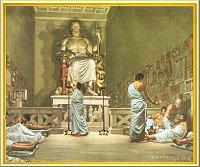 CLICK TO ENLARGE |
| Asclepius was represented as a handsome and manly figure, much like Zeus. He was seated on his throne, holding a staff in one hand, and with the other resting on the head of a serpent/dragon. By his side lay a dog. |
[HOME]
[MYTHOLOGY'S
EFFECTS ON MODERN SOCIETY] [OLYMPIANS]
[GALLERY]
[MAJOR GODS]
[MINOR GODS]
[HEROES]
[CONTACT]
[LOVE STORIES]
[MYTH OF THE
MONTH] [FUN
STUFF] [CREATURES]
Web, myth narration and graphics created and maintained by Nick Pontikis
Copyright © 1995 Nick Pontikis
Thanasi's Olympus Greek
Restaurant
Copyright 1999 mythman.com
greekmythologytoday.com
mythmaniacs.com
The Myth Man persona copyright 1988 Nick Pontikis
